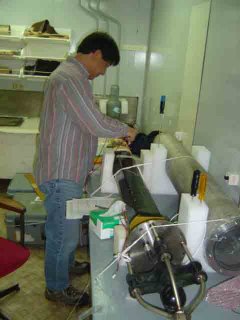November 20, 2006

On board the RV Yuzhmorgeologiya:
The day dawned brightly without a cloud in the sky. The seas are calmer than expected. The Magellen Passage is treating us kindly. We are taking advantage of the fair weather to prepare the research equipment for deployment.
Haru Matsumoto spent the day assembling and testing the hydrophones on board. Seven hydrophones were deployed last year: one in Drake’s Passage and six in the in the Bransfield Strait between the South Shetland Islands and the Antarctic Peninsula. We hope to recover the hydrophone in Drake’s passage on our way to the Korean base on King George Island. The plan is to eventually recover all seven and re-deploy five hydrophones in the Bransfield Strait. This will require replacing their hard drives and batteries. The hard drives contain all of the acoustic data since last year, but the sounds signals can’t be analyzed until our return to the States.
Batteries power both the hydrophone and acoustic release. In fact, there are 150 “D” cells (flashlight batteries) in each hydrophone. These provide power both to the sound amplifier and hard drive. The batteries in the acoustic release are necessary to open the coupling between the hydrophone and the railroad wheel. The railroad wheel acts as an anchor, maintaining the hydrophone at a specific depth. When the acoustic release is activated, a previously attached float brings the hydrophone to the surface for recovery.
Joe Haxel and Del Bohnenstiehl were preparing equipment for another type of essential research: sampling the water column. The chemistry of the seawater changes as it circulates in an active vent system. Vent systems can be detected by the presence of different types (isotopes) of helium.
A CTD array (Conductivity/Temperature/Density) will be lowered from the ship. CDT arrays consist of 12 or more bottles that can be selectively closed at different depths to capture and isolate different seawater samples. Joe and Del constructed special copper sample tubes that will be used to transport the seawater samples back to the laboratory for analysis. The plan is for six casts of the CDT to obtain 40 samples.
I’m retiring to our cabin tonight under high clouds and relatively calm seas.
(Photo: Haru Matsumoto assembles hydrophones)



0 Comments:
Post a Comment
<< Home